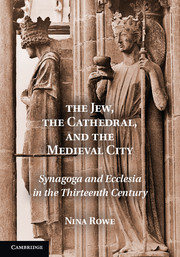Book contents
- Frontmatter
- Contents
- List of Illustrations
- Acknowledgments
- Abbreviations
- Introduction: The Jew, the Cathedral, and the Medieval City
- PART I IMAGINING JEWS AND JUDAISM IN LIFE AND ART
- 1 The Jew in a Christian World: Denunciation and Restraint in the Age of Cathedrals
- 2 Ecclesia and Synagoga: The Life of a Motif
- PART II ART AND LIFE ON THE ECCLESIASTICAL STAGE – THREE CASE STUDIES
- Notes
- Glossary
- Bibliography
- Index
1 - The Jew in a Christian World: Denunciation and Restraint in the Age of Cathedrals
Published online by Cambridge University Press: 05 January 2012
- Frontmatter
- Contents
- List of Illustrations
- Acknowledgments
- Abbreviations
- Introduction: The Jew, the Cathedral, and the Medieval City
- PART I IMAGINING JEWS AND JUDAISM IN LIFE AND ART
- 1 The Jew in a Christian World: Denunciation and Restraint in the Age of Cathedrals
- 2 Ecclesia and Synagoga: The Life of a Motif
- PART II ART AND LIFE ON THE ECCLESIASTICAL STAGE – THREE CASE STUDIES
- Notes
- Glossary
- Bibliography
- Index
Summary
The era around the turn of the thirteenth century witnessed a series of fundamental shifts in Christian conceptions of Jews and Judaism. From the time of the early church on, Jewish scripture had been considered a prophetic antecedent to the Christian Bible; ancient Jewish history had been seen as an account of the prehistory of the Christian church; and Jews themselves were understood as having been preserved within Christian society on the ground that they were living witnesses to the era of the church's foundations. In the years between roughly 1175 and 1225, however, theologians began to recognize that the actual Jews living in Europe did not conform to the ideal images Christians had formulated for them, igniting a campaign to restrict Jewish intellectual and spiritual life. In the realm of the law, papal pronouncements had long defended Jews against attack. But around the year 1200 new statements from Rome qualified Jewish protections, limited Jewish economic activity, and sought to mark Jews as an alien presence living in the midst of Christian society. On the streets of Europe's expanding cities, meanwhile, animosities grew as Christians became increasingly indebted to Jewish moneylenders and rumors that Jews ritually murdered Christian children circulated.
The monumental sculptures of Ecclesia and Synagoga at Reims, Bamberg, and Strasbourg were installed during the era when these new spiritual notions, legal codes, and societal phenomena were crystallizing. In this chapter I shall analyze the religious and social developments to which those sculptures respond.
- Type
- Chapter
- Information
- The Jew, the Cathedral and the Medieval CitySynagoga and Ecclesia in the Thirteenth Century, pp. 15 - 39Publisher: Cambridge University PressPrint publication year: 2011



